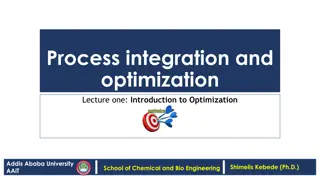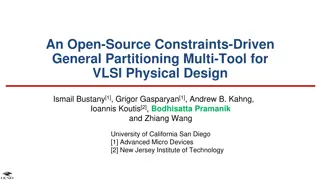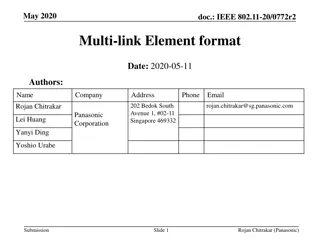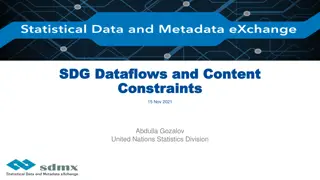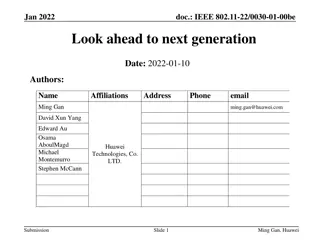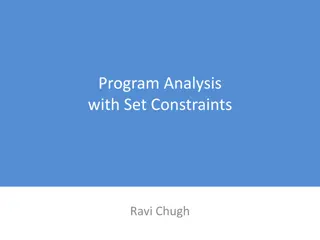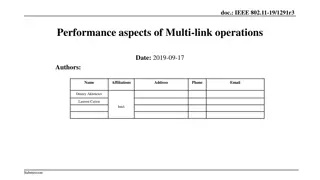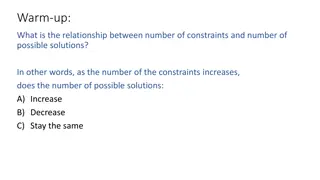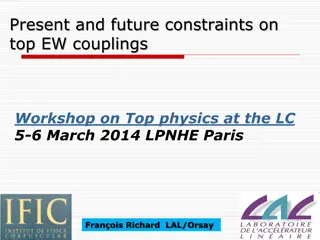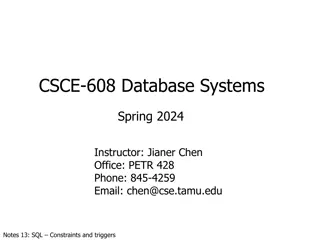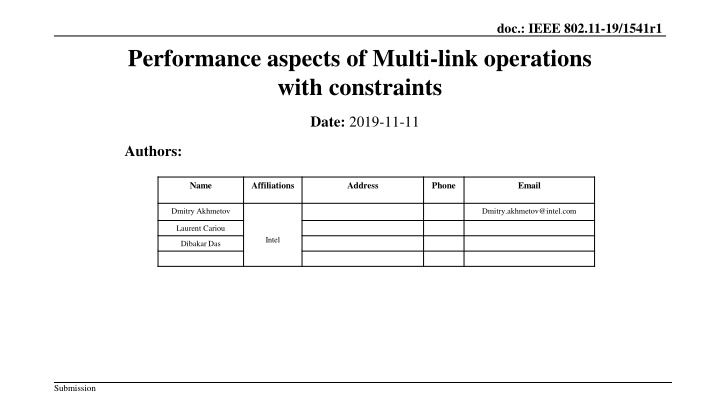
Performance Aspects of Multi-Link Operations with Constraints
Explore the performance implications of multi-link device operations in IEEE 802.11 networks, focusing on modes of operation with constraints arising from physical limitations of co-located radios. The discussion includes proposed classifications, preferred modes of operation, and the introduction of new modes with restrictions to address interference issues.
Uploaded on | 1 Views
Download Presentation

Please find below an Image/Link to download the presentation.
The content on the website is provided AS IS for your information and personal use only. It may not be sold, licensed, or shared on other websites without obtaining consent from the author. If you encounter any issues during the download, it is possible that the publisher has removed the file from their server.
You are allowed to download the files provided on this website for personal or commercial use, subject to the condition that they are used lawfully. All files are the property of their respective owners.
The content on the website is provided AS IS for your information and personal use only. It may not be sold, licensed, or shared on other websites without obtaining consent from the author.
E N D
Presentation Transcript
doc.: IEEE 802.11-19/1541r1 Performance aspects of Multi-link operations with constraints Date: 2019-11-11 Authors: Name Affiliations Address Phone Email Dmitry Akhmetov Dmitry.akhmetov@intel.com Laurent Cariou Intel Dibakar Das Submission
doc.: IEEE 802.11-19/1541r1 Recap: EHT MLLE 1 In [1] we proposed classification of multi-link device operations based on channel access capabilities SPC single primary channel operation MPC multiple primary channel operation JMPC join multiple primary channel operation We discussed performance aspects of a device with multi-link capabilities in comparison to a single link operation with a conclusion that MPC is a preferable mode of operation ~1.27x gain for SPC mode of operation ~2.09x gain for MPC mode of operation ~2.22x gain for JMPC mode of operation In this presentation we will focus on modes of operation with constraints arising from physical limitations of co-located radios STA STA Link 2 Link 1 STA STA EHT MLLE 2 Submission 2
doc.: IEEE 802.11-19/1541r1 Complicated life of a device with co-located radios Multi-link device may need to impose constraints on concurrent TX/RX operations on different bands For example, interference across links/radios - TX on band 1 can impact radio on band 2 (and vice versa). Levels of interference/leakage across links vary depending on device capabilities and link/channel location in a frequency domain Devices radio capabilities / implementation may not allow for concurrent operation No TX operation is possible on band1 if band 2 is busy with RX operation and vice versa TXOP TXOP Tx data Tx data Tx data Rx ack Rx ack Rx ack MLLE STA band 1 STA1 3 2 1 0 4 3 2 1 0 5 TXOP TXOP Rx ack Tx ack R x Tx data Rx data Tx data band 2 Tx data Tx Rx ack STA 2 Rx ack 1 0 Introducing 2 new modes of operation with restrictions isolated (R)estricted MPC Non-isolated (R)estricted MPC Submission 3
doc.: IEEE 802.11-19/1541r1 Restricted mode of operations assumptions isolated RMPC Leakage/interference from TX on link1 is not sufficient to cross ED threshold on link2 Leakage still add interference noise sufficient to harm data frame receptions on a high MCSes but not enough to damage RX of control frames non-isolated RMPC Leakage from TX on link1 is sufficient to cross ED threshold on link2 Leaking power rise CCA Busy signal on link 2 stopping it from contention and destroying all ongoing RX events/processes Channel access rules to accommodate restrictions: Before initiating TXOP on a link1 MLLE STA need to verify status of a link 2 do not initiate TX operation if other link/radio is in RX state unless STA is not an intended receiver of that transmission do not initiate TXOP if a response is expected on link 2 do not initiate TXOP if STA on link 2 is going to send a response frame on link 2 if the other link/radio is in TX state, limit own TX duration to match end of the other transmission If status of link 2 does not allow MLLE STA to initiate TXOP, restart backoff counter on link 1 AP is considered a better device and can operate under isolated RMPC while STA operates under non-isolated RMPC rules AP initialize TXOP operations in a way to avoid interfering with RX activity of a STA operating under non-isolated RMPC on another link. AP does not initiate TXOP on link 1 if it detect UL transmission from a STA operating under non-isolated RMPC on another link Synchronization of TX/TX and RX/Rx operations, i.e. packet level/PHY level synchronization across links is desirable Submission 4
doc.: IEEE 802.11-19/1541r1 Simulation setup. DL case SU HE, 2x2x80, MCS11 BSS TXOP limit 5.4ms OBSS STA 1 OBSS STA n OBSS AP n OBSS AP1 STA1 AP1 OBSS TXOP limit: uniformly distributed for each TXOP between 1 and 5.4ms Link 1 EHT AP EHT STA No TXOP bursting OBSS STA2 OBSS AP 2n OBSS STA 2n OBSS AP 2 RTS/CTS on Link 2 AP2 STA2 A-MPDU size: 256 BSS load: UDP traffic in DL direction with load of Case 1: 300Mbps, e.g. 25% of MCS11 rate; Case 2: 600Mbps, e.g. 50% of MCS11 rate; Case 3: 1200Mbps, e.g. 100% of MCS11 rate For each case vary number of OBSSes from 0 to 10 Each OBSS has bidirectional UDP traffic with total load 120Mbps ( e.g.10% MCS11 rate) All BSSes are in ED/PD range of each other Metrics of interest Throughput # of synchronous/asynchronous operations ( simultaneous TXOP start) Submission 5
doc.: IEEE 802.11-19/1541r1 Restricted vs Unrestricted. DL case Depending on the link load there might be a huge impact on throughput. In certain cases (high link load, lightly loaded BSS/OBSS) dual link performance might be converging to a single link operation performance A potential for improvement/proprietary implementation exist OBSS equally affect all modes of operation Submission 6
doc.: IEEE 802.11-19/1541r1 Latency, MLLE, benefits It is expected that throughput of MLA will be reduced at the STA MLLE with Tx/Rx constraints STA MLLE cannot simultaneously Tx in one link and Rx in another adjacent link due to leakage Under certain conditions multi-link operation will be converging to a single link operation We still may expect improved of latency from having more than one active contending channel Even without/limited multi-link operation a multi-link channel access shall provide some gain in terms latency Submission 7
doc.: IEEE 802.11-19/1541r1 Simulation setup. UL case AP MLLE associated with MLLE STA on link 1 and 2 doing UL only traffic, AC_VO OBSS STA 4 OBSS STA 1 OBSS AP4 OBSS AP1 1 legacy STA on each link receiving DL traffic, AC_VI 4 OBSS APs with 1 STA with DL traffic, AC_VI Configuration 1: Legacy STA Link 1 STA AP EHT AP EHT STA UL traffic: 512 bytes packets every 20ms @ MCS4 OBSS STA 4 OBSS STA 1 OBSS AP4 OBSS AP1 Link 2 Legacy STA AP STA DL traffic: @ MCS0 with load as % TX rate 1a: all the DL traffic from EHT AP is for legacy STA 1b: all the DL traffic from EHT AP is for EHT STA Configuration 2: UL CBR traffic, 1500bytes packets of 12Mbps @ MCS8 DL traffic as above Configuration 3: UL bursty traffic, 6Mbps packets of 12Mbps @ MCS8 DL traffic as above Submission 8
doc.: IEEE 802.11-19/1541r1 Example: CDF view of Configuration 1, 50% BSS DL load The spread between curves is explained by the time required for MLLE to identify address of the intended receiver in case of one link if found it RX state Submission Slide 9
doc.: IEEE 802.11-19/1541r1 Light CBR UL traffic (Config 1a) The gap between MPC and RMPC is more pronounced when the OBSS load is smaller relative to the BSS load (due to lower number of events when early detection occurs). Submission Slide 10
doc.: IEEE 802.11-19/1541r1 Light CBR UL traffic (Config 1b) ~38% reduction in latency from SPC to RMPC when the network is congested. Gap between MPC and RMPC therein is about 25%. Submission Slide 11
doc.: IEEE 802.11-19/1541r1 Heavy UL CBR traffic (Config 2) ~44% reduction in latency from SPC to RMPC when the network is congested. Gap between MPC and RMPC therein is ~16%. Submission Slide 12
Month Year doc.: IEEE 802.11-19/1541r1 Heavy UL bursty traffic (Config 3) ~30% reduction in latency from SPC to RMPC when the network is congested. Gap between MPC and RMPC therein is ~28%. Submission John Doe, Some Company Slide 13
doc.: IEEE 802.11-19/1541r1 Conclusion For STAs without Tx/Rx constraints, MPC mode of operation performs very well For STAs that have Tx/Rx constraints, both isolated and non isolated RMPC mode of operations preform much better than fully synchronized access Average performance gain from multi-link operation over a single link operation MPC mode of operation: isolated RMPC mode of operation: non-isolated RMPC: SPC mode of operation: DL case: 2.07x; DL case: 1.91x; DL case: 1.6x* ; DL case: 1.27x; * Note: performance gain varies a lot depending on a BSS load from 1.16 with 25% BSS load to 1.77 with 100% BSS load and OBSS loads of 10% to 40% Even with Tx/Rx constraints, MLLE still can provide benefits in terms of reduced latency Both for RTA-like traffic and heavy bursty traffic 30% and more improvement observed for congested networks MLLE performance is better the sooner it can resolve RX activity on a busy link Operational modes with constraints, including non-isolated cases, require additional study/simulations A definition/clarification of channel access mechanism with constraints is desirable A better definition for constraints is required Submission 14
doc.: IEEE 802.11-19/1541r1 Appendix [1] Performance aspects of Multi-link operations, 11-19-1291/02 Submission 15
doc.: IEEE 802.11-19/1541r1 Single link vs Multi-link. DL case Submission 16
doc.: IEEE 802.11-19/1541r1 Classification: Completely synchronous (S)ingle (P)rimary (C)hannel, SPC TXOP TXOP TXOP band 1 0 3 2 1 3 2 1 2 1 0 0 AP1 busy busy busy TXOP band 2 AP2 Perform contention on primary channel Do energy detect for PIFS on a secondary channel If IDLE transmit over two channels If BUSY transmit on primary only Submission 17
doc.: IEEE 802.11-19/1541r1 Classification: Completely asynchronous, (M)ultiple (P)rimary (C)hannels, MPC TXOP TXOP busy band 1 2 5 4 1 3 0 6 9 8 7 1 0 3 2 AP1 TXOP busy TXOP TXOP band 2 3 2 0 1 0 2 1 4 3 2 1 0 AP2 Perform contention independently on both links Transmit/receive independently on both links Submission 18
doc.: IEEE 802.11-19/1541r1 Classification: Semi-asynchronous (J)oin (M)ultiple (P)rimary (C)hannels, JMPC TXOP TXOP TXOP TXOP band 1 0 2 1 4 3 7 6 5 8 9 3 2 1 0 AP1 busy TXOP busy TXOP band 2 4 3 2 1 0 7 6 2 1 0 AP2 Perform contention independently on each link If one channel/link won contention - verify status of a another channel/link If another link is in IDLE/Contention state transmit jointly Otherwise transmit using on available link only Submission 19
doc.: IEEE 802.11-19/1541r1 Mean Latency (Config 1b) Submission 20
doc.: IEEE 802.11-19/1541r1 Mean Latency (Config 2) Submission 21

